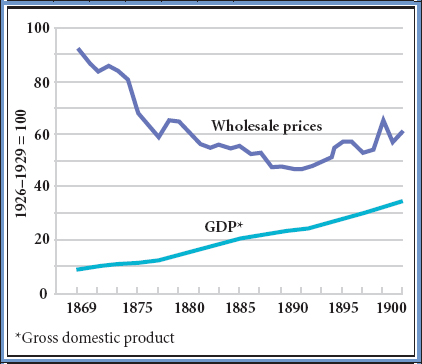America’s History: Printed Page 546
America: A Concise History: Printed Page 499
America’s History: Value Edition: Printed Page 483
The Rise of Big Business

In the late 1800s, industrialization in Europe and the United States revolutionized the world economy. It brought large-scale commercial agriculture to many parts of the globe and prompted millions of migrants — both skilled workers and displaced peasants — to cross continents and oceans in search of jobs. Industrialization also created a production glut. The immense scale of agriculture and manufacturing caused a long era of deflation, when prices dropped worldwide (Figure 17.1).
Falling prices normally signal low demand for goods and services, and thus stagnation. In England, a mature industrial power, the late nineteenth century did bring economic decline. But in the United States, production expanded. Between 1877 and 1900, Americans’ average real income increased from $388 to $573 per capita. In this sense, Andrew Carnegie was right when he argued that, even though industrialization increased the gap between rich and poor, everyone’s standard of living rose. In his famous 1889 essay “Wealth” — later called “The Gospel of Wealth” — he observed that “the poor enjoy what the rich could not before afford. What were the luxuries have become the necessaries of life.”

|
To see a longer excerpt of “The Gospel of Wealth,” along with other primary sources from this period, see Sources for America’s History. |
Technological and business efficiencies allowed American firms to grow, invest in new equipment, and earn profits even as prices for their products fell. Growth depended, in turn, on America’s large and growing population, expansion into the West, and an integrated national marketplace. In many fields, large corporations became the dominant form of business.